|
 Secure Site
Secure Site
|
 |
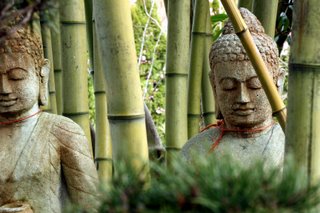 creating sacred spaces Meditation and other spiritual practices are basic to enhancing energy—they create balance and improve the quality of your home or office. In fact, the best thing you can do to create a sacred santuary (to improve the supportiveness of a space) is to do spiritual practices (sadhana). Prayer, meditation, yoga, chanting, and pranayama all enliven a space.
Be consistent with the spiritual practices of whatever tradition you are drawn to. As the Sufi poet Rumi said, your true home is within and reachable by letting go and allowing the mind to go inward. When we feel at home within ourselves and within our own hearts, any building we live in will feel more serene and supportive. Meditation practices make us more perceptive of our environment, so that we intuitively know many of the changes to make. We become more in touch, literally and metaphorically. According to Vastu, the northeast or the center of the home is the best area for meditation rooms, spiritual altars, and yogic practices.
adapted from Yoga Internation by Sherri Silverman
Use our unique “Zen Clock” which functions as a Yoga & Meditation Timer. It features a long-resonating acoustic chime that brings your meditation or yoga session to a gradual close, preserving the environment of stillness while also acting as an effective time signal. Our Yoga Timer & Clock can be programmed to chime at the end of the meditation or yoga session or periodically throughout the session as a kind of sonic yantra. The beauty and functionality of the Zen Clock/Timer makes it a meditation tool that can actually help you “make time” for meditation in your life. Bring yourself back to balance.
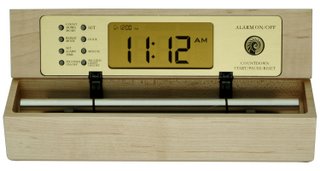 tools for meditation, zen timer Now & Zen – The Yoga Timer & Clock Store
1638 Pearl Street
Boulder, CO 80302
(800) 779-6383
Posted in Feng Shui, Meditation Timers, Meditation Tools, mindfulness practice, Well-being
 acoutic music The theme of spiritual life as a kind of awakening is a metaphor found in every culture and tradition. You might enjoy listening to music by the great German composer Johann Sebastian Bach, who chose the theme of awakening for a cantata he composed in 1731. Inspired by the Gospel of Matthew 25:1–13, it opens with the words, “Wachet auf, ruft uns die Stimme” (Sleepers awake! The Voice calls to us).
adapted from Yoga International, by Rolf Sovik, PsyD, The author of Moving Inward: The Journey to Meditation.
Boulder, Colorado—an innovative company has taken one of life’s most unpleasant experiences (being startled awake by your alarm clock early Monday morning), and transformed it into something to actually look forward to. “The Zen Alarm Clock,” uses soothing acoustic chimes that awaken users gently and gradually, making waking up a real pleasure. Rather than an artificial recorded sound played through a speaker, the Zen Clock features an alloy chime bar similar to a wind chime.
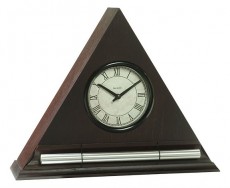 acoutic musical alarm clocks with chime Now & Zen – The Zen Alarm Clock Store
1638 Pearl Street
Boulder, CO 80302
(800) 779-6383
Posted in Zen Timers
 Guided Meditation Practice limitless awareness and let yourself be as infinite as the heavens.
This is the third guided meditation in a series that started two days ago:
Turn your attention from the surface of the lake toward the sky itself. Then imagine shifting your gaze from the reflections, the passing phenomena, to the sky within which they all arise and pass away. The sky is boundless, limitless. It contains everything that arises. The horizon is only a perceptual or conceptual boundary that can never be reached. Even on the cloudiest day, the sky is luminous above the clouds, pervasive, limitless, and free.
Awareness has the qualities of luminosity and limitlessness. It is present always, behind, between, and beyond all the ever-changing phenomena. Whenever you catch yourself identifying with the mental “clouds,” simply shift your identification from the clouds to the sky itself. Realize that what you’ve been seeking is what you already are and have always been! Big Sky Mind opens us to seeing that our true nature is this awareness within which all experience arises and passes away.
adapted from Yoga Journal by Frank Jude Boccio
Although meditation can be done in almost any context, practitioners usually employ a quiet, tranquil space, a meditation cushion or bench, and some kind of timing device to time the meditation session. Ideally, the more these accoutrements can be integrated the better. Thus, it is conducive to a satisfying meditation practice to have a timer or clock that is tranquil and beautiful. Using a kitchen timer or beeper watch is less than ideal.
And it was with these considerations in mind that we designed our digital Zen Alarm Clock and practice timer. This unique “Zen Clock” features a long-resonating acoustic chime that brings the meditation session to a gradual close, preserving the environment of stillness while also acting as an effective time signal.
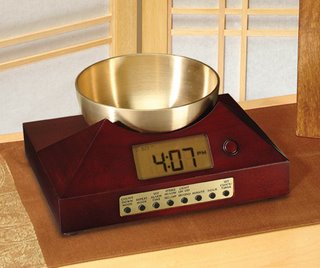 Meditation Timer with Tibetan Bowl Now & Zen – The Meditation Timer Store
1638 Pearl Street
Boulder, CO 80302
(800) 779-6383
Posted in yoga, Yoga Timer, Yoga Timers by Now & Zen
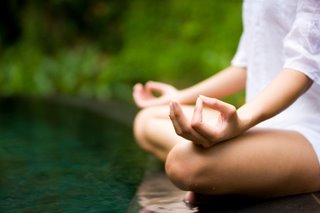 Finding balance is one of life’s great goals, but it can be as elusive as it is desirable. Change your approach and its true nature will emerge. Finding balance is one of life’s great goals, but it can be as elusive as it is desirable. Change your approach and its true nature will emerge.
When you’re balanced, you can feel it. You get the sense that your life is moving along steadily. You take things in stride. You feel healthy and vibrant, challenged by your life, but relaxed enough to enjoy it; protected by the familiar, but excited by the possibilities ahead. So why does achieving it — and maintaining it — seem so difficult to do for so many of us?
Study balance a little closer, and you realize that what many of us perceive to be the ideal balance is in fact not balance at all. Unlike, say, a balanced scale, a balanced life is not symmetrical, still, or neutral. Like riding a bike, living a balanced life comes easier to you as you gain momentum. From that perspective, the myths and truths that follow in each day’s blog can help you find a new understanding of balance — and, finally, a way to get there yourself.
adapted from Body + Soul
Although meditation can be done in almost any context, practitioners usually employ a quiet, tranquil space, a meditation cushion or bench, and some kind of timing device to time the meditation session. Ideally, the more these accoutrements can be integrated the better. Thus, it is conducive to a satisfying meditation practice to have a timer or clock that is tranquil and beautiful. Using a kitchen timer or beeper watch is less than ideal.
And it was with these considerations in mind that we designed our digital Zen Alarm Clock and practice timer. This unique “Zen Clock” features a long-resonating acoustic chime that brings the meditation session to a gradual close, preserving the environment of stillness while also acting as an effective time signal.
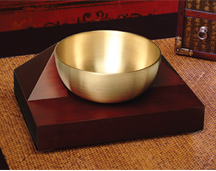 Singing Bowl Meditation Timer
Our Zen Timepiece’s acoustic 6-inch brass bowl-gong clock is the world’s ultimate alarm clock, practice timer, and “mindfulness bell.”
Our Zen Timepiece’s acoustic 6-inch brass bowl-gong clock is the world’s ultimate alarm clock, practice timer, and “mindfulness bell.”
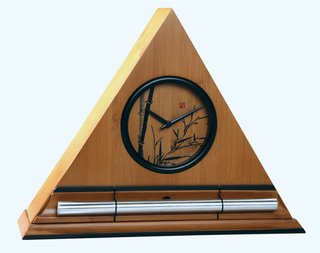 Zen Alarm Clock with Gentle Wake Up Chime Now & Zen
The Singing Bowl Meditation Timer Store
1638 Pearl Street
Boulder, CO 80302
(800) 779-6383
Posted in Bamboo Chime Clocks
 finding balance Myth: Balance is effortless.
Truth: Balance is efficient.
In physics, equilibrium is a state in which all external forces cancel each other out, with no one force exerting dominance over the other. That’s how balance can work, too; it’s not that you’re not exerting any effort, it’s that you’re providing just the right amount for each need.
When you’re balanced, your exertion is distributed so well — your big muscles doing the big work and your little muscles carrying a lighter load — it feels effortless even though it’s anything but. One way to tune in to your balance is to appreciate your physical balance, whether through running, walking, or doing yoga or any activity that calls for focus.
adapted from Body + Soul
Although meditation can be done in almost any context, practitioners usually employ a quiet, tranquil space, a meditation cushion or bench, and some kind of timing device to time the meditation session. Ideally, the more these accoutrements can be integrated the better. Thus, it is conducive to a satisfying meditation practice to have a timer or clock that is tranquil and beautiful. Using a kitchen timer or beeper watch is less than ideal.
And it was with these considerations in mind that we designed our digital Zen Alarm Clock and practice timer. This unique “Zen Clock” features a long-resonating acoustic chime that brings the meditation session to a gradual close, preserving the environment of stillness while also acting as an effective time signal.
 timers for finding balance in your life
Now & Zen – The Chime Meditation Timer Store
1638 Pearl Street
Boulder, CO 80302
(800) 779-6383
Posted in Meditation Timers, Meditation Tools, mindfulness practice, Well-being
 Five ways to change your brain Five Ways to Change Your Brain
1. Redecorate a room in your home — move things around so you interact with the space in a slightly different way.
2. If you’re left-brained, or rigidly organized, experiment with allowing for some comfortable disarray
3. If you’re right-brained, try adopting some organizational systems for your home or office that will help you access information you need that you can never find.
4. Ask yourself what a friend would choose the next time you go shopping or redecorate.
5. Stop spending time on things you don’t need to do. A balanced life is really imbalanced. Spend more time doing what you love.
adapted from Body + Soul, Text by Terri Trespicio
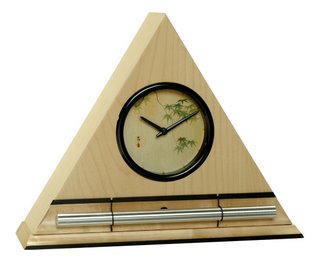 gentle wake up clocks with chimes Testing yourself is one of the best ways to get a feel for balance — which is why a great way to experience balance in your life is to change the way you do some normal, everyday things. Of course, changing everything at once is sure to throw you off, but try one thing at a time.
Although meditation can be done in almost any context, practitioners usually employ a quiet, tranquil space, a meditation cushion or bench, and some kind of timing device to time the meditation session. Ideally, the more these accoutrements can be integrated the better. Thus, it is conducive to a satisfying meditation practice to have a timer or clock that is tranquil and beautiful. Using a kitchen timer or beeper watch is less than ideal.
And it was with these considerations in mind that we designed our digital Zen Alarm Clock and practice timer. This unique “Zen Clock” features a long-resonating acoustic chime that brings the meditation session to a gradual close, preserving the environment of stillness while also acting as an effective time signal.
 The Zen Alarm Clock Store - Boulder, Colorado
Now & Zen – The Zen Alarm Clock Store
1638 Pearl Street
Boulder, CO 80302
800) 779-6383
Posted in Well-being
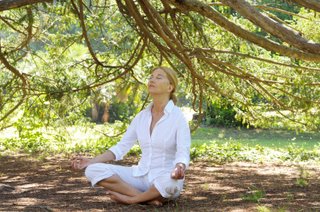 meditation for relaxation It’s no surprise that being consumed with anger can bring on a headache. But worse than expressing your ire is not expressing it. According to researchers at the St. Louis University School of Medicine, bottling up rage may play a bigger role in head pain than anyone ever imagined. Psychologist Robert Nicholson asked 422 people various questions meant to uncover their headache triggers, and the answers pointed to one thing: “Holding in anger was the most important emotional factor in whether or not they were going to experience headaches,” says Nicholson. Why does allowing your frustration to fester bring on the pain? “I wish I had a good answer,” Nicholson says. “We’re getting research underway to figure out the physiology behind it. Muscle tension probably plays a role, but some people think there’s also some interaction of the emotional component of the brain with pain receptors.” Whatever those pathways turn out to be, the answer isn’t just to let anger fly but to figure out ways to keep it from eating away at you. Experts advise learning relaxation techniques, such as deep breathing, yoga, meditation, or biofeedback. You might also want to see a therapist who can help you learn healthy ways to express your anger. Your head—and your friends—will thank you.
adapted from Natural Solutions, October 2003
Although meditation can be done in almost any context, practitioners usually employ a quiet, tranquil space, a meditation cushion or bench, and some kind of timing device to time the meditation session. Ideally, the more these accoutrements can be integrated the better. Thus, it is conducive to a satisfying meditation practice to have a timer or clock that is tranquil and beautiful. Using a kitchen timer or beeper watch is less than ideal.
And it was with these considerations in mind that we designed our digital Zen Alarm Clock and practice timer. This unique “Zen Clock” features a long-resonating acoustic chime that brings the meditation session to a gradual close, preserving the environment of stillness while also acting as an effective time signal.
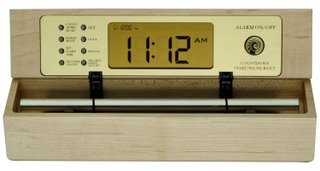 Meditation Timers with Chime, a natural acoustic sound not electronic Now & Zen – The Zen Meditation Timer Store
1638 Pearl Street
Boulder, CO 80302
(800) 779-6383
Posted in Chime Alarm Clocks
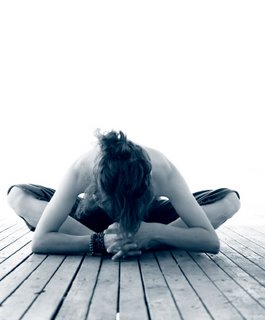 yoga Yoga can be a powerful healing tool for overcoming back pain. But there are times when your practice can do more harm than good. “Too often, students don’t back off a pose until there’s pain,” says Jamie Elmer, a yoga instructor in Boulder, Colorado. “Hurting even just alittle bit is a sign that you have to change something.” Elmer challenges students to answer this question: Why are you coming to yoga? “Are you coming for a distraction from something else? That’s what TV is for. A yoga practice without mindfulness can lead to injury quickly.”
If you have a history of lower back pain, keep these do’s and don’ts in mind when you practice, says Elmer:
DO vary the intensity of your practice. “If we do anything repetitively, day after day, and we haven’t built up the internal strength for that activity, the body won’t be ready for it, and injury will result,” says Elmer. Like any type of exercise, mix up the style of yoga you practice. If you do a vigorous, Ashtanga class one day, seek out a more meditative and calming class the next, so you’re not repeating strenuous movements too often.
DON’T go into any pose to your fullest range of motion. “When you’re in that kind of extreme, you’re not using muscle control,” she says. The result? Risky joint compression in your hips, knees, and spine.
DO use your abdominal muscles and bend your knees when going into a forward bend to prevent overstretching in your lower back.
DO use your abs and keep your legs strong in back-bending poses, including cobra and upward-facing dog.
DON’T twist with a rounded spine. “More important than how deeply you can twist is how long your spine is when you do,” says Elmer.
adapted from Natural Solutions, October 2009
Use our unique “Zen Clock” which functions as a Yoga Timer. It features a long-resonating acoustic chime that brings your meditation or yoga session to a gradual close, preserving the environment of stillness while also acting as an effective time signal. Our Yoga Timer & Clock can be programmed to chime at the end of the meditation or yoga session or periodically throughout the session as a kind of sonic yantra. The beauty and functionality of the Zen Clock/Timer makes it a meditation tool that can actually help you “make time” for meditation in your life. Bring yourself back to balance.
 Yoga Timers with gentle chimes Now & Zen – The Zen Timer and Alarm Clock Store
1638 Pearl Street
Boulder, CO 80302
(800) 779-6383
Posted in yoga, Yoga Timer, Yoga Timers by Now & Zen
 Warm winter sun “Imagine yourself outside on a beautiful Saturday afternoon, just in the flow, enjoying life. Suddenly the sun disappears behind a cloud that you didn’t know was there. It’s dark now, and you feel off kilter, sad.”
That’s how LeNeva Spires, who works as an executive assistant at a university in Portland, Oregon, describes the seasonal affective disorder (SAD) that affects her every autumn.
Though classified as a type of depression, “it feels more like something is missing, like things are not quite right,” says Spires.
It’s precisely brightness (or rather, the lack of it) that triggers this mood disorder, one of few health problems tied to a season. SAD primarily affects people who live in northern latitudes (above San Francisco and Washington, D.C.), and more women than men. It often begins in September or October, as the days shorten, and lingers until spring.
SAD tends to respond readily to the very thing we’re missing in the winter months: light. Learn how to get more of it as well as discover the best foods, exercise, supplements, and herbs to create your action plan for a brighter, happier winter.
1. Let There Be Light
For seasonal depression and the winter blahs, “the treatment of choice is light,” says psychiatrist Alfred Lewy. How do you get that light? You could move closer to the equator, where the sun rises and sets at a more consistent time all year long. Or, if your family and work life allow it, you could change your sleep schedule during the winter so you wake up a half-hour after sunrise (check your local paper to find out when the sun rises), and then go immediately outside.
But for most of us, the easiest option is to purchase a light box outfitted with special bulbs that mimic the brightness of the morning sun. Light therapy works by getting our sleep-wake cycle to synchronize with an electric-powered “sun,” thereby resetting our circadian clock. We tend to feel our best when we wake with the dawn, and the light box essentially helps you make your own dawn.
Light-Box Lowdown
Available online and at specialty stores (starting at about $160), light boxes are safe to use at home, whether or not you have an official diagnosis of SAD. Lewy recommends placing the light box at a 45-degree angle to you, from either the side or above, and starting with a morning dose of light: about 30 minutes, taken between 6 a.m. and 8 a.m. Some people may need more time — 45 minutes, or even up to two hours — but once they feel an improvement in their mood, they can reduce the sessions to 30 minutes.
The light receptors that help rest our circadian clocks reside in our eyes, so keep your eyes open during light treatment. In fact, Lewy suggests glancing sideways at the lightbulbs once or twice every minute (something you should never do with the real sun).
A small number of SAD sufferers respond best to early-evening light treatments. After a week or two of morning treatment, if you notice no improvement even with two-hour doses, try the evening sessions instead, suggests Lewy. People usually begin to feel better within a few days but should keep up the treatments daily, ideally from the onset of symptoms (usually in September or October) through at least March.
 bring on the night 2. Bring On the Night
You need a good night’s sleep in order to mitigate winter depression — and by “good,” Emmons means sleeping for eight or nine hours a night — but not more. Keep bedtime and wake-up time consistent, too; Emmons suggests going to bed between 10 and 11 p.m. and rising between 6 and 7 a.m.
Melatonin Matters
While light-box therapy remains the primary remedy for synchronizing your sleep patterns, supplementing with melatonin (the “darkness” neurotransmitter) may help, too. The brain’s melatonin levels rise to their highest level at night, and people normally start secreting the hormone a few hours before bedtime, to prime the body for sleep.
Like light therapy in the morning, taking melatonin supplements in the afternoon can help shift the circadian clock. In fact, Lewy often prescribes both morning light and 0.3 mg to 0.5 mg of melatonin in the afternoon for best results in resyncing the circadian processes. Since melatonin can make some people sleepy, avoid driving as you figure out the best dosage. You’ll find melatonin tablets at natural-foods stores.
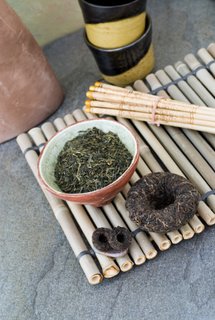 eat well 3. Eat to Feel Good
What we eat can affect our brain chemistry and our mood. To combat SAD, Emmons recommends focusing on foods that increase and stabilize levels of serotonin, a mood-improving hormone that tends to decrease in the winter. These foods include choices rich in tryptophan, a building block of serotonin.
We often crave high-carbohydrate comfort foods in winter, but it’s wise to resist the urge, he says. As he explains it, indulging in refined carbs, such as white bread and white rice, may indeed offer an initial feel-good spike in serotonin levels. But, as with a sugar rush, refined carbs end up depleting our serotonin levels soon after.
Instead, eat a variety of complex carbohydrates, such as barley, brown rice, oats, and other whole grains, and include a small amount of lean protein, ideally a high-tryptophan protein (turkey, cheese, eggs) at each meal or snack. Also include leafy green vegetables, such as kale and bok choy, which provide mood-supporting B vitamins and minerals that help convert tryptophan into serotonin.
4. Move and Stretch
“Exercise helps [all types of depression] for many reasons,” says Emmons. It boosts serotonin levels in the brain; it improves circulation, which gets more blood and nutrients to the brain; it increases energy and metabolism, even at the cellular level; and it improves glucose regulation, which also affects energy levels.
For those taking antidepressant medication, exercise helps improve the effectiveness of the drug, likely by improving circulation. More of the medicine gets to the brain, where it’s needed, and the body metabolizes the drug more easily, which reduces side effects.
The best news about SAD and exercise, says Emmons, is that you don’t have to take your workout to the extreme. Mild aerobic exercise for 30 minutes can usually lighten your mood. If it’s not too cold, walking outdoors is a great option. At the gym, try the stationary bike or treadmill for a half-hour every day.
5. Supplement Smartly
Several dietary supplements can help fill in any nutritional gaps and in turn may lift your mood. Emmons says his clients have had success with the following four:
Vitamin D
Deficiency in this vitamin is extremely common and may contribute to both ordinary and seasonal depression (along with other illnesses). While light boxes substitute for the sun in certain ways, they don’t provide this critical nutrient (which is more of a hormone than a vitamin). In the winter, a vitamin D supplement can help regulate your mood.
Dosage: 2,000 IU of vitamin D3 daily
Multivitamin
A good one includes plenty of B vitamins, as well as key minerals such as selenium (which helps support mood) and magnesium (which reduces anxiety and muscle tension).
Dosage: 1 daily
B-Vitamin Complex
These assist the brain in producing neurotransmitters such as serotonin and norepinephrine.
Dosage: One B-50 supplement daily (along with the multivitamin)
Omega-3-Rich Fish Oil
Studies suggest that omega-3 fatty acids may help prevent and ease depression and other mood disorders. Flax makes a good substitute for strict vegetarians.
Dosage: 1,000 mg of fish oil in capsule form twice daily, or 1 tablespoon of flax oil twice a day
6. Take It Outside
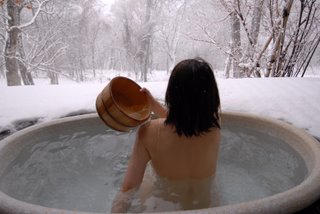 go outside to cheer up Spending time outdoors helps us reconnect with nature, says Emmons, thus healing a rift that seems to lie at the heart of seasonal depression. If you combine a serotonin-boosting exercise with your outdoor time — like a brisk walk at a local park or an afternoon of cross-country skiing — you’re combating the winter blues on two fronts.
During the summer, take advantage of the sunlight by spending 15 to 20 minutes a day in the sun without sunscreen (unless you’re at risk of skin cancer). This will help build your vitamin D levels for next year.
7. Try Healing Herbs
Certain medicinal plants ease the winter blues, says Margi Flint, who runs the Earthson Herbals school in Marblehead, Massachusetts.
Uplifting Tea
For a mild, mood-boosting infusion, simmer 1 ounce oatstraw in 1 quart of water for 40 to 60 minutes. Remove from heat, add 2 tablespoons of dried chamomile and 2 tablespoons of dried lemon balm; cover and steep for 15 minutes. Strain and drink several cups daily.
Aromatherapy
Since the smell of any citrus uplifts the spirit, add a total of 10 drops of any combination of lemon, lime, and orange essential oils to each ounce of lotion or massage oil. Use daily, or use these oils in a diffuser.
Daily Tonic
Holy basil, ashwaganda, and gotu dola — from India’s traditional system of medicine, Ayurveda — help ease depression. Flint suggests using the powdered form; add a 1/4 teaspoon of each to oatmeal or applesauce.
8. Don’t Go It Alone
As with any form of depression, working with a mental-health professional for SAD can be beneficial. If you experience suicidal thoughts or other serious symptoms, seek help immediately.
One of the ultimate Zen like experiences is waking-up from a great slumber refreshed and energized. Your mind and body are harmoniously one, both alert and focused. Having a refreshed mind and body are two keys to a natural and Zen lifestyle. Waking up in the morning should not be a loud and abrupt awakening, but rather it should be a peaceful positive experience. The right natural alarm clock can transition your deep and tranquil sleep into a serene start to consciousness. Imagine a long-resonating Tibetan bell-like chime waking you up to a beautiful morning experience.
The right alarm clock can be the most beneficial investment for you. With our Now & Zen natural alarm clock you are awakened more gradually and thus more naturally. Now & Zen is focused on creating a naturalistic lifestyle, and our clocks are an example of our philosophy.
adapted from Body + Soul, January/February 2009
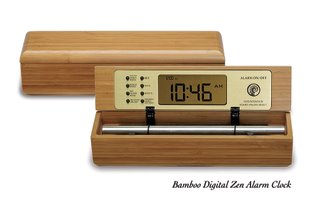 Bamboo Alarm Clocks & Meditation Timers
Now & Zen – Gradual Chime Alarm Clock Store
1638 Pearl Street
Boulder, CO 80302
(800) 779-6383
Posted in Goodness, Insomnia, intention, sleep, Sleep Habits, Well-being, Zen Timers
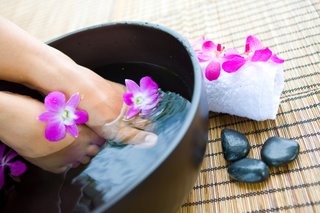 feet in foot spa bowl with orchids After a busy week, why not treat yourself like a flower in need of some care and pampering?In the healing tradition of Ayurveda, we’ve have created a rejuvenating summer routine that you can do at home on a weekend — one that consists of such indulgent pleasures as soothing masks, herbal baths, calming yoga poses, and seasonal meals. Come Monday morning, no matter what, you’ll emerge feeling refreshed, collected, and looking your best.
Morning Yoga
Greet the day with a gentle yoga routine. Poses such as Bow Pose, Downward Dog, and spinal twists help balance pitta.
Breakfast
For the first meal on each of these two days, eat a large bowl of fruit salad with a tall glass of freshly squeezed orange juice. This meal will help your body get rid of accumulated toxins. If you find orange juice too acidic, you may substitute pitta herbal tea (available at Indian grocery stores) or any other fresh fruit juice of the season. You may also prepare a blended fruit smoothie in place of the fruit salad. In a blender, combine a large banana with 1/2 cup of your choice of seasonal fresh fruits and 1/2 cup of water to thin it out.
Spa Treatments
Spend an hour or two luxuriating in the pitta-balancing spa treatments. On Saturday, you’ll focus on your skin and body; on Sunday, you’ll treat the hair, hands, and feet.
Down Time
Spend the late part of the morning as you like — reading an interesting book, listening to music, writing in your journal, gardening, painting. The choices are endless. It is important, though, to spend time unwinding and doing what you want rather than what you think you should do.
Lunch
After your morning yoga and spa therapies, enjoy a large raw salad made with fresh seasonal green vegetables such as cucumber, celery, and sprouts. Choose pitta-balancing herbs and spices like cilantro and basil to add flavor. Eat your lunch slowly and mindfully, focusing on the flavors and textures of the ingredients. To unlock your mind, reflect on the view from your window, or even the sight of indoor plants and flowers, while you eat.
 - treat yourself to some rest
Rest
Exercise
Your retreat will be enhanced by a brisk walk, preferably in the open air so you can breathe fresh oxygen directly into your lungs. Stay conscious of good posture, and warm up by starting out at a slow pace then building to a brisk pace. Keep your chest out, swing your arms wide, and breathe through your mouth. Walk for 20 to 30 minutes. If you prefer, swimming is also a good exercise for balancing pitta.
Digestive Meditation and Care
This is an ideal time to tune in to and become familiar with your digestive system. Place your hands first on your stomach and become aware of any slight movements, feelings, or sounds. Do the same with your small intestines in your midriff area and then with the area under your navel. Mentally prepare for your next meal by noticing whether you are hungry or not. Resolve to eat only as much as you need to fill three-quarters of your stomach (this typically translates to about as much food as will fit into both your cupped hands). Using a little bit of oil, massage your stomach in round circles, moving clockwise. This will help you digest the last meal and prepare your body for the next.
Dinner
Dinner during the retreat should consist of steamed vegetables. As with lunch, use fresh, green seasonal vegetables — the greener the better. For extra flavor, add fresh herbs such as rosemary, basil, parsley, and sage, or pine nuts, sesame seeds, or pumpkin seeds. As with lunch, eat slowly and mindfully, which will allow for complete digestion. An hour or so after dinner, enjoy an herbal tea.
 Bath and Bedtime Bath and Bedtime
Run a bath prepared with ingredients to balance pitta — rose, neem, jasmine, basil. You may use fresh or dried leaves and herbs; bundle a handful of ingredients in a piece of muslin cloth to make a tea bag for your tub. Or, if you prefer, add a few drops of essential oils directly to the bathwater. If you like, use candles, fresh flowers, and music to aid relaxation. As you soak in the bath, close your eyes and breathe deeply, releasing tension with each exhalation. Keep yourself warm after the bath and go to bed, relaxed and at peace.Rest is important to calm the mind and allow the physical body to deal with fatigue. After eating, take some quiet time to listen to music, read, or take a short nap for half an hour to an hour if you are sleepy. If you are tired but cannot fall asleep, then simply rest your mind and body by lying down and emptying your mind of thoughts.
One of the ultimate Zen like experiences is waking-up from a great slumber refreshed and energized. Your mind and body are harmoniously one, both alert and focused. Having a refreshed mind and body are two keys to a natural and Zen lifestyle. Waking up in the morning should not be a loud and abrupt awakening, but rather it should be a peaceful positive experience. The right natural alarm clock can transition your deep and tranquil sleep into a serene start to consciousness. Imagine a long-resonating Tibetan bell-like chime waking you up to a beautiful morning experience.
The right alarm clock can be the most beneficial investment for you. With our Now & Zen natural alarm clock you are awakened more gradually and thus more naturally. Now & Zen is focused on creating a naturalistic lifestyle, and our clocks are an example of our philosophy.
adapted from Body + Soul, June 2005
Now & Zen – The Zen Alarm Clock Store
1638 Pearl Street
Boulder, CO 80302
(800) 779-6383
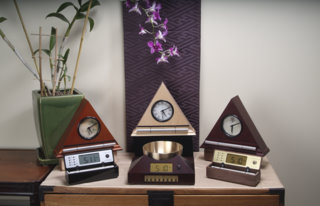 Now & Zen's Family of Products
Posted in intention
|
|
|
|